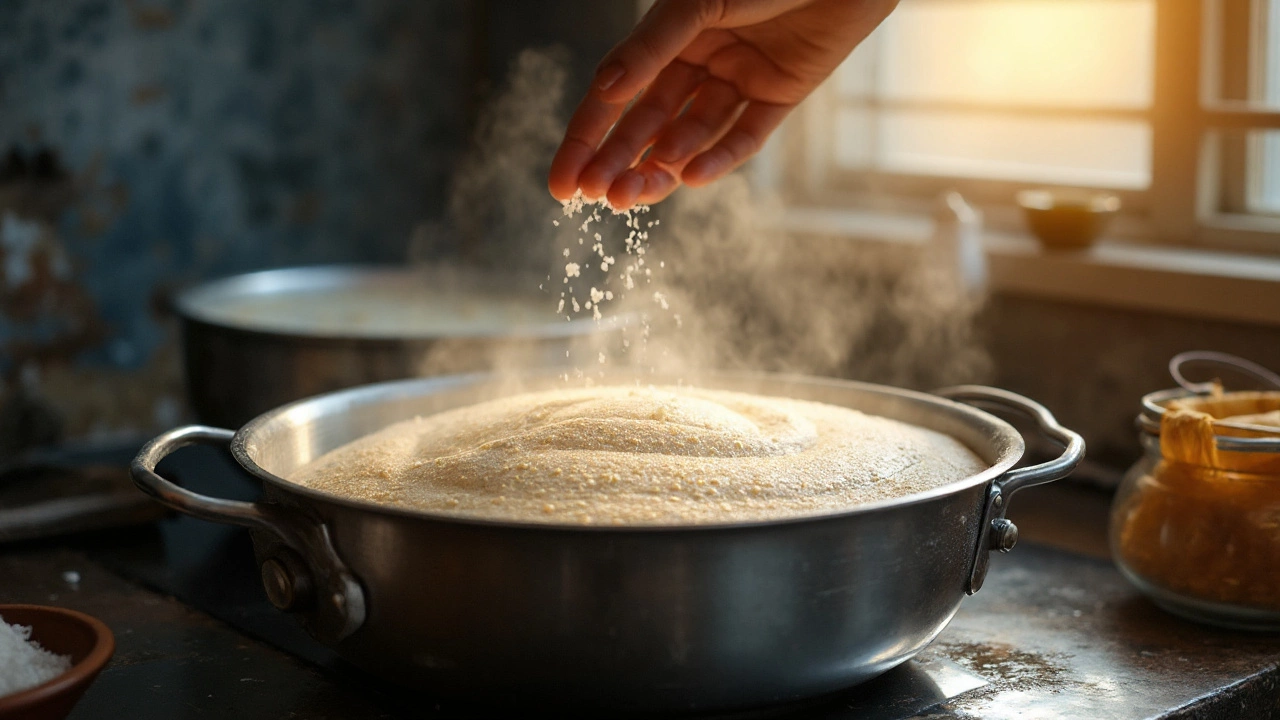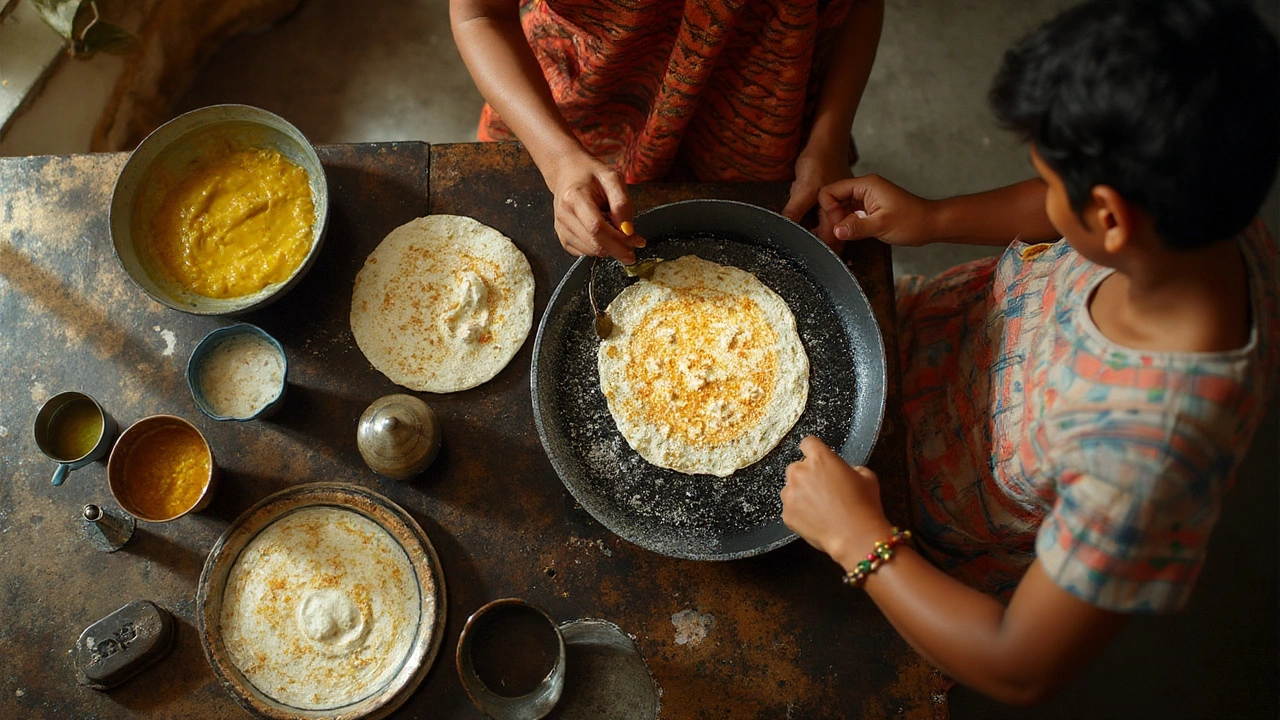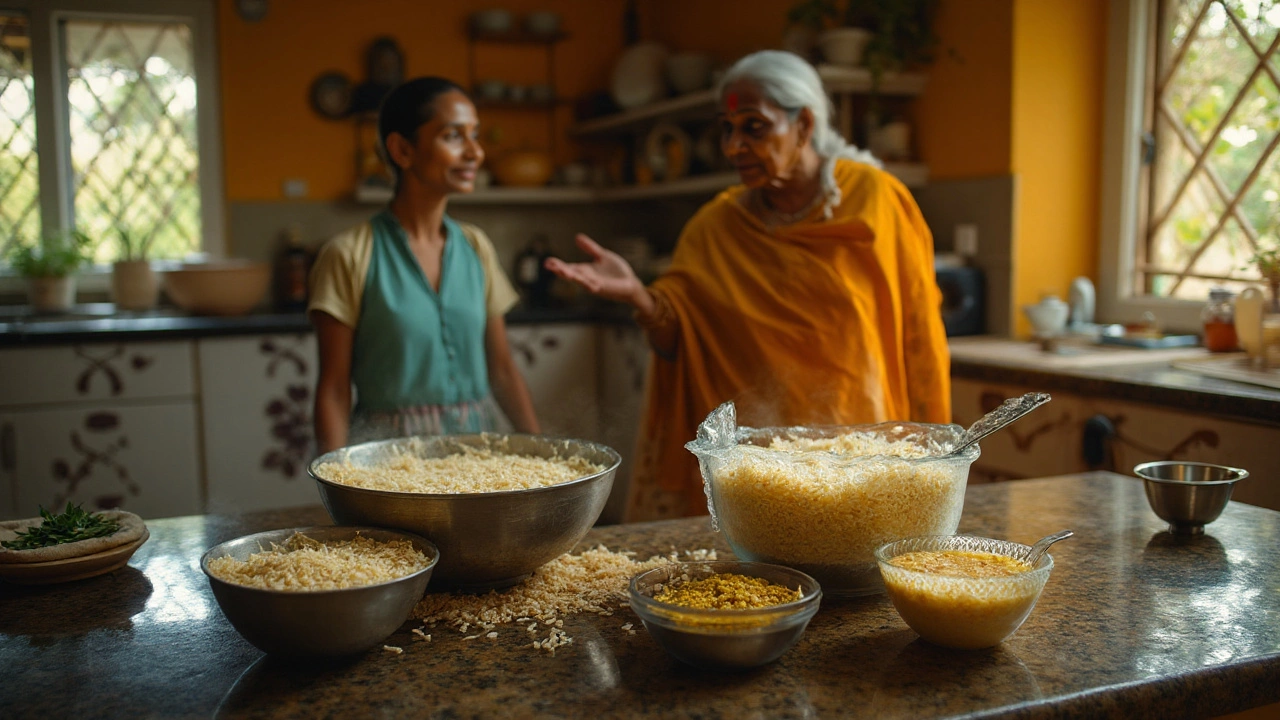You want a crisp, lacy dosa without babysitting two bowls all day. So the big question: can you soak rice and urad dal together and still get great dosa? Short answer-yes, you can. But it helps to know when it works beautifully, when it backfires, and the exact tweaks that keep the batter light, bubbly, and reliable.
- Yes, you can soak together for dosa (not ideal for idli). It saves time and dishes, and it’s fine if you grind together too.
- For the most consistent results-especially if you want a batter that also makes soft idlis-soak and grind separately.
- Ratios: 1 part urad dal : 2.5-3 parts rice for dosa. Add 1 tsp fenugreek seeds per cup urad for better fermentation.
- Soaking time: 4-6 hours in warm weather; 6-8 hours in cool weather. Use filtered water for better fermentation.
- Grind logic: Urad should be fluffy and airy; rice a little coarse for crisp dosas. That’s why separate grinding is gold-standard.
- Fermentation: 8-12 hours at 25-30°C; 12-18 hours at 20-24°C; longer if it’s cold. Keep batter at 25-30°C if you can.
The short answer, plus when to soak together vs separately
Here’s the core trade-off. Soaking together is convenient, and for dosa-only batter it usually works. Soaking (and grinding) separately gives you more control over texture and lift. Urad needs a very fine, fluffy grind to trap air and build that springy network that helps fermentation. Rice needs a slightly coarser grind for the classic crispy edge. When everything is soaked and ground together, you lose some control over these two different textures.
What does the science say? Food fermentation work from CFTRI (Mysuru) has documented how lactic acid bacteria and yeasts colonize idli/dosa batter as it ferments, producing acid and gas that raise the batter. Fenugreek seeds add mucilage that helps aeration and improves grind stability. Rinsing reduces surface starches and some antinutrients, and warmer temperatures speed up both enzyme activity and microbial growth. You don’t need to memorize the microbiology-just remember warmth, clean water, and oxygen-friendly grinding make better batter.
So, should you soak together? Use this quick rule of thumb:
- Soak together if: you’re making dosa-only batter; you have a high-speed blender (not a stone wet grinder); it’s warm (25-32°C); you plan to grind the whole mixture together; you want to save time.
- Soak separately if: you want a two-in-one batter for idli and dosa; you own a wet grinder and care about the best texture; your dal is old (harder to aerate); it’s cool (below ~20°C) so you need every fermentation advantage; you use whole urad gota (bigger kernels that benefit from focused soaking and grinding).
Pros and cons at a glance:
- Soak together-pros: fewer bowls, less fuss, fine for crisp dosa; faster prep when it’s warm; works with parboiled or raw rice.
- Soak together-cons: slightly weaker urad aeration if you grind together; harder to dial in different textures; not ideal for idlis.
- Soak separately-pros: fluffy urad, controlled rice texture, stronger fermentation, more forgiving in cool weather, best for idli-dosa combo batter.
- Soak separately-cons: more steps, more washing up, a bit longer on prep day.
One more thing no one tells you: water quality matters. In cities with treated water (hello from Sydney), chlorine can slow fermentation. If your batter is sluggish, try filtered water for soaking and grinding. It’s a small change with a big pay-off.

Step-by-step: dosa batter your way (together or separate)
Pick one of the two methods below. Both work for dosa. The “classic” separate method gives you a reliable batter that also makes nice idlis. The “quick” together method is perfect for busy weekdays-and yes, it still produces crisp, tasty dosas.
Ratios (by volume or weight)
- Urad dal (whole gota or split, skinless): 1 part
- Rice: 2.5 to 3 parts for dosa (closer to 2.5 if you like a little softness; 3 for crisper).
- Fenugreek seeds (methi): 1 tsp per cup of urad dal (optional but recommended).
- Optional: 2-3 tbsp poha (flattened rice) per cup urad for extra crispness and browning.
- Salt: 1 to 1.5 tsp per 3 cups rice + 1 cup urad (adjust to taste).
Pick your rice: For dosa, raw rice (short/medium grain) or a mix of raw and parboiled is great. Parboiled rice browns a bit less but gives structure. Avoid long-grain basmati-it’s aromatic but not the best texture for dosa.
Equipment notes: High-speed blender? Keep batter cool with ice-cold water so you don’t heat-kill the microbes. Wet grinder? You can add water slowly and get incredible urad aeration.
Method A - Soak together, grind together (quick dosa method)
- Rinse 1 cup urad dal + 2.5-3 cups rice under running water until the water runs mostly clear. Add 1 tsp fenugreek seeds. Optional: add 2-3 tbsp poha in the last hour of soaking.
- Soak in filtered water that sits at least 3-4 cm above the grains. Warm weather (25-32°C): 4-6 hours. Cooler (18-24°C): 6-8 hours. Stir once or twice; urad tends to float-push it under so it hydrates evenly.
- Drain well and reserve the soaking water in case you need it for grinding (if it’s not too starchy). Add fresh cold water gradually while grinding.
- Grind the entire mix until smooth but not pasty. Aim for a slightly sandy feel between fingers-like super-fine semolina. If using a blender: pulse, scrape, and add cold water in small splashes. Don’t let batter heat up above lukewarm.
- Salt: In warm weather, add salt after fermentation to avoid over-souring. In cool weather, you can add before fermentation.
- Ferment in a warm spot until batter increases in volume and looks bubbly. Ideal batter rises 50-100% and smells pleasantly tangy, not sharp.
- Thin with a splash of water before cooking dosas. The batter should flow like heavy cream and spread easily on a hot pan.
Method B - Soak separately, grind separately (classic dosa/idli-friendly method)
- Rinse 1 cup urad dal (with 1 tsp fenugreek) in several changes of water. Rinse 2.5-3 cups rice separately.
- Soak each in separate bowls. Same timing: 4-6 hours warm weather, 6-8 hours cool. Add 2-3 tbsp poha to the rice bowl in the last 30-60 minutes if you want more crispness.
- Grind urad first. Add minimal water and let it whip up until very fluffy. If you pinch and rub it, it should feel like light cream, not gritty.
- Grind rice next with a bit more water than urad. Keep it a touch coarse-like fine rawa. In a wet grinder, you’ll add water slowly; in a blender, pause to keep things cool.
- Mix the two batters with clean hands for 1-2 minutes. The warmth of your hand and gentle aeration help fermentation kick off.
- Salt: Warm weather-add later. Cool weather-add now.
- Ferment until risen and bubbly. Then thin down for dosa or use thick for idli.
Water and temperature tips
- Use filtered or boiled-and-cooled water if your tap water smells strongly of chlorine.
- Keep the batter at 25-30°C to ferment predictably. In winter, pop it in the oven with the light on, or near a warm appliance.
- Don’t overheat while grinding. Batter that gets hot ferments slowly and can taste flat.
How long to ferment? Use temperature, not the clock. Here’s a practical guide.
| Room temp (°C) | Likely fermentation time | What you’ll see | Tips |
|---|---|---|---|
| 15-18 | 18-24 hours | Slow rise, few bubbles | Use warm spot; add 1 tbsp cooked rice to jump-start |
| 19-22 | 12-18 hours | Moderate rise, light sourness | Salt before ferment is fine; keep batter covered but not airtight |
| 23-26 | 8-12 hours | Good rise, many bubbles | Watch closely near the end; don’t overproof |
| 27-32 | 6-8 hours | Fast rise, strong aroma | Salt after grind or mid-ferment; avoid direct sunlight |
How to tell your batter is ready
- It’s risen by about half to double, feels lighter when you stir, and shows tiny bubbles throughout.
- It smells pleasantly tangy, like mild yogurt-not sharp or boozy.
- A small spoonful in water should float or at least hesitate before sinking (a rough sign of aeration).
Quick dosa checklist (save this)
- Ratio for dosa: 1 cup urad : 2.5-3 cups rice.
- Add 1 tsp methi per cup urad; optional 2-3 tbsp poha for extra crispness.
- Use cold water to grind; keep batter cool.
- Ferment around 25-30°C; use filtered water if fermentation is sluggish.
- For lacy dosas, thin batter slightly more and spread on a hot pan; for sturdy dosas, keep it a bit thicker.

Troubleshooting, variations, and mini‑FAQ
Things go wrong even for seasoned cooks. Here’s how I fix them in my Sydney kitchen, where summers are easy mode and winters need a little help.
If you soaked together and batter feels weak
- Try a longer ferment within a safe window. Give it another 2-3 hours at warm room temp.
- Next batch, add 1-2 tbsp more urad per cup and grind a bit longer to build air.
- Stir in 1-2 tbsp rice flour before cooking to tighten a too-runny batter for crisper dosas.
If batter didn’t rise
- Warm it up (oven light on) and wait.
- For the next batch, use filtered water and add 1 tbsp cooked rice while grinding-it feeds microbes.
- Check your salt. Too much salt at the start slows fermentation. In hot weather, salt later.
If batter over-fermented (too sour, very runny)
- Chill immediately to slow down.
- Add a small portion of fresh ground rice batter (no salt) to balance, or mix in 1-2 tbsp rice flour and a pinch of sugar to help browning.
- Use it for rava-like dosas or uttapams with toppings-it’ll still taste great.
If dosas tear or stick
- Pan wasn’t hot enough. Heat until a drop of water sizzles and skates.
- Too much oil before spreading makes batter slip. Grease lightly after you spread.
- Batter too thick. Thin a little with water, whisk well, and try again.
If dosas aren’t crisp
- Grind rice a bit coarser next time.
- Thin batter slightly more and spread thinner on a hotter pan.
- Add 2-3 tbsp poha during soaking next time, or 1-2 tbsp fine semolina to the fermented batter.
Variations that work
- Rice options: Raw rice (short/medium grain), idli rice (parboiled), or a 50:50 mix. For dosa-only, raw rice often gives better crispness.
- Dal options: Whole urad gota ferments beautifully; split urad works too and soaks faster. If your dal is old, soaking separately helps.
- Millets: You can replace up to 30% of rice with foxtail/kodo little millets. Soak times are similar; keep millet slightly coarse.
Mini‑FAQ
- Can I soak together but grind separately?
Yes. Rinse well, soak together, then drain and use a slotted spoon/sieve to scoop out most of the urad to grind first. It’s not perfect, but it’s a good middle path when you’re short on time. - Do I need fenugreek?
Not mandatory, but it helps fermentation and grinding. Traditional studies out of CFTRI describe improved batter stability with methi. I use it especially in winter. - What about idli?
For fluffy idli, soak and grind separately. You want maximum urad aeration and a smoother rice grind. Soaking together isn’t ideal for idli texture. - Should I add salt before or after fermentation?
Cool weather: before is fine. Hot weather: add after grinding or mid-ferment to avoid over-souring. Salt slows microbes a bit. - Can I use basmati rice?
It works in a pinch, but texture will be less classic. Mix with short/medium-grain rice if that’s what you have. - Is baking soda okay?
Only as a last-minute fix for a sluggish batter and only a pinch. Good fermentation gives better flavor and browning. - Fridge soak?
Yes, if it’s very hot. Extend soak time by a couple of hours; grind with cold water. - Do I need a wet grinder?
No. A high-speed blender works. Just keep it cool and give urad enough time to turn fluffy.
When soaking together makes the most sense
- Weeknights when you just want dosa for dinner and you’re not planning idlis.
- Warm, humid days where fermentation is a breeze and you don’t need maximum urad lift.
- Small batches in a blender-less than 4 cups total grain mix.
When soaking separately is worth it
- You want one batter for both idli and dosa.
- Your urad is old and stubborn or you’re in a cold spell.
- You own a wet grinder and want to take advantage of it.
Next steps
- If you’re new: try the quick “soak together + grind together” once. Log your timings and room temp. See how your kitchen behaves.
- If you want a no-miss batter: switch to separate soaking and grinding. You’ll notice more rise and easier fermentation.
- Dial your ratio. Start at 1:2.75 (urad:rice). Go up to 1:3 for extra-crisp dosas or down to 1:2.5 for a little softness.
My home-cook heuristics
- Warm day in Sydney (28°C): 4 hours soak, 8 hours ferment, salt after ferment.
- Cooler evening (20-21°C): 6 hours soak, 12-14 hours ferment, salt before ferment, oven light on overnight.
- Blender gets hot? Add a few ice cubes while grinding; it won’t hurt the batter.
Bottom line: soaking together isn’t a mistake-it’s a choice with trade-offs. For crisp dosa on a busy day, go for it. For the most reliable fermentation and a batter that doubles as idli batter, keep the rice and dal apart until the mixing stage. Either way, once you learn how your kitchen’s temperature, water, and tools behave, your dosa routine becomes autopilot-and your tawa stays busy.
